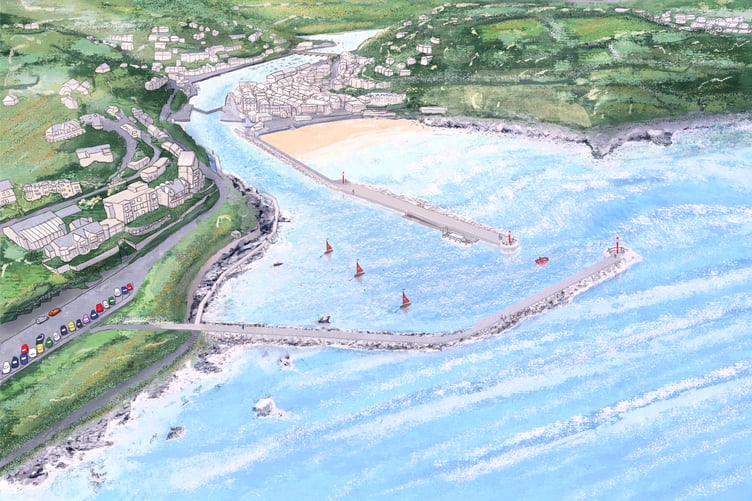IT has been announced that an alternative proposal for protecting Looe from flooding put forward by the Save the Banjo Pier group (SBP) will not be taken forward to the next stage of the Looe Flood Defence and Regeneration Scheme following a three-month investigation.
It was found that the scheme did not meet the required viability tests and struggled to meet safety requirements.
The Looe Flood Defence and Regeneration Scheme is being led by Cornwall Council. The council is also liaising with a number of local organisations, including Looe Harbour Commissioners, Looe Town Council, Looe Development Trust, West Looe Town Trust, East Looe Town Trust, the RNLI and local MP Sheryll Murray.
Seven potential options for delivering the aims of the flood defence and regeneration scheme were presented at the public engagement events in June and July 2023. The top two options selected by the community were the tidal barrier with breakwaters and the tidal barrier only option.
Prior to the engagement events, a petition opposing these options was created and an alternative option was put forward by the Save Banjo Pier group.
Aimed primarily at protecting Banjo Pier, the proposed SBP scheme involves constructing a smaller breakwater at the mouth of the river and a low-level flood wall throughout both sides of the town.
The walls stop around Looe Bridge. The option includes a West Looe pathway extension to the new breakwater and Hannafore, which is a popular feature of the tidal barrier and breakwaters option.
As each of the other options had already been assessed against a range of technical, economic and environmental criteria, it was agreed that the Save Banjo Pier proposal needed to be assessed using the same criteria to see if it was safe and viable before a more detailed assessment was carried out.
In its current state, the SBP’s proposal did not meet the relevant criteria to be taken forward to the next stage – to do so the proposal will need to demonstrate how it would promote economic growth in addition to protecting Looe from frequent and severe flooding for the next 50 to 100 years.
Making the economic regeneration case would be vital to securing the funding needed to deliver the SBP’s scheme.
Martyn Alvey, Cornwall Council’s portfolio holder for environment and climate change, said: “We took the option put forward by the Save Banjo Pier group very seriously and welcomed their positive commitment to work with the team to assess their proposal.
“Securing the funding needed to protect Looe from flooding in the future will require the whole town to work together. There are many other places across the country seeking funding for flood prevention works and the Government and other potential investors. It will be important to show significant support for the final scheme.”
Over the past three months a number of meetings and workshop sessions were held with the SBP group and other stakeholders to look at the proposals in more detail.
This work included investigating issues relating to safety, including berthing of vessels, breakwater functions, available harbour and safe refuges, accessibility at different states of the tide and wave climate. The safety assessment identified a number of issues relating to the design of the SBP proposal.
A spokesperson said: “SBP option will create greater navigational risks as vessels will be forced east, pushing them into conflict with swimmers and other users of the popular East Looe beach in shallow waters.
“There is also a threat to the structure of Banjo Pier caused by rising sea levels and climate change which will bring more frequent and severe storms.
“There are also concerns over the size of the harbour entrance, with the larger entrance proposed by the SBP option resulting in significantly higher waves which would make it hazardous for people getting on and off boats and, in severe weather, could cause damage to the SBP proposed pontoon unless it was removed and stored is a safe location. In addition, the inability of the SBP option to significantly reduce wave energy will also have a knock-on effect to the necessary height of walls to be provided in the harbour. Unless the wall height is increased, the standard of flood protection to the town will be reduced thus reducing its economic benefit.”
The viability assessment investigated the costs of maintaining Banjo Pier and the existing harbour walls created by the SBP proposal.
It was reported that the pier is already subject to wave over-wash which is damaging the structure and forcing closure for public safety reasons. As sea levels rise the pier will be over topped more frequently and this will eventually lead to major repairs or rebuilding being needed.
A spokesperson continued: “Although the SBP option would mean that Banjo Pier would not be extended, work will still be needed to strengthen the structure in the future.
“Taking into account the costs of the group’s revised wall alignment and the costs of strengthening Banjo Pier, the estimated outline costs of constructing the SBP option is £164m.
“Looe will be competing for funding with other flood prevention projects up and down the country. To secure funding the business case will need to demonstrate how the scheme will protect key transport links, including main roads in and out of the town and rail services, as well as how it will protect and enhance the visitor and marine economy.”
It was said that detailed work was carried out on the potential for the option to deliver growth for the town – this was shared with the SBP group who were invited to come up with additional means of economic regeneration in order to be able to afford the cost.
A spokesperson added: “Although the smaller southern breakwater would provide some additional berthing for day trip and glass bottomed boats, the lack of depth at all states of the tide would create significant difficulties for both deeper drafted vessels and ferries, meaning that a scheduled ferry service would not be able to operate. This will have an impact on the projected number of visitors, and on visitor spend, in the town.”
To be considered viable a scheme needs to have a Benefit to Cost Ratio (BCR) score of at least 1.
A spokesperson explained: “The BCR scores for the top two options as selected by the community (Tidal Barrier and Breakwaters (TB+B) option and Tidal Barrier only option (TB)) are now 2.32 and 3.21 respectively.
“Comparing the costs of the SBP scheme with the economic benefit results in a Benefit to Cost Ratio of 0.98. As this is below one, this means that the SBP option fails to pass the economic viability test.”
Cllr Alvey commented: “We have worked closely with the Save Banjo Pier (SBP) group to assess their option and would like to thank members of the group for the positive way in which they have engaged with us.
“Unfortunately, the analysis has shown that the SBP option does not meet the required viability criteria and so will not be taken forward to the next stage.
“This means that work will focus on developing the Outline Business Case based on the shortlisted Tidal Barrier with Breakwaters and the Tidal Barrier only options which will deliver the aims of the scheme. This is currently due to be submitted to the Government in the Spring.
“We recognise that the SBP group will be disappointed by this outcome. However, we hope that they will work with us to develop and support the business case and help to secure the funding needed to protect Looe from increased flooding over the next 50 to 100 years and promote economic growth in the town and the wider East Cornwall area.”
Since the news that the SBP’s proposal would not be taken forward – the group have responded.
A spokesperson from the Save Banjo Pier group said: “Of course we are disappointed with the outcome, but we are not surprised.
“Our alternative proposal was failed by a measurement system that values misguided metrics over sensible projects. The Benefit Cost Ratio (BCR) for the SBP proposal was low because it was an actual flood defence scheme, not an outer harbour vanity project. The outer harbour scheme insists on recklessly dumping concrete into the marine environment, which in itself will not stop flooding due to tidal height, but will destroy the picturesque town that we all know and love. The BCR for this scheme is skewed due to the measurements love for over the top projects, with an alleged ferry port bringing visitors to the town, spending millions, if you’ll believe it.
“Prioritising these grandiose plans over genuine flood defence strategies risks unnecessary environmental devastation and the demise of local businesses which will be unlikely to survive the years of disruption.
“Our heritage is at risk, the world-renowned Banjo Pier will be unrecognisable and the destruction will be irreversible.”





Comments
This article has no comments yet. Be the first to leave a comment.